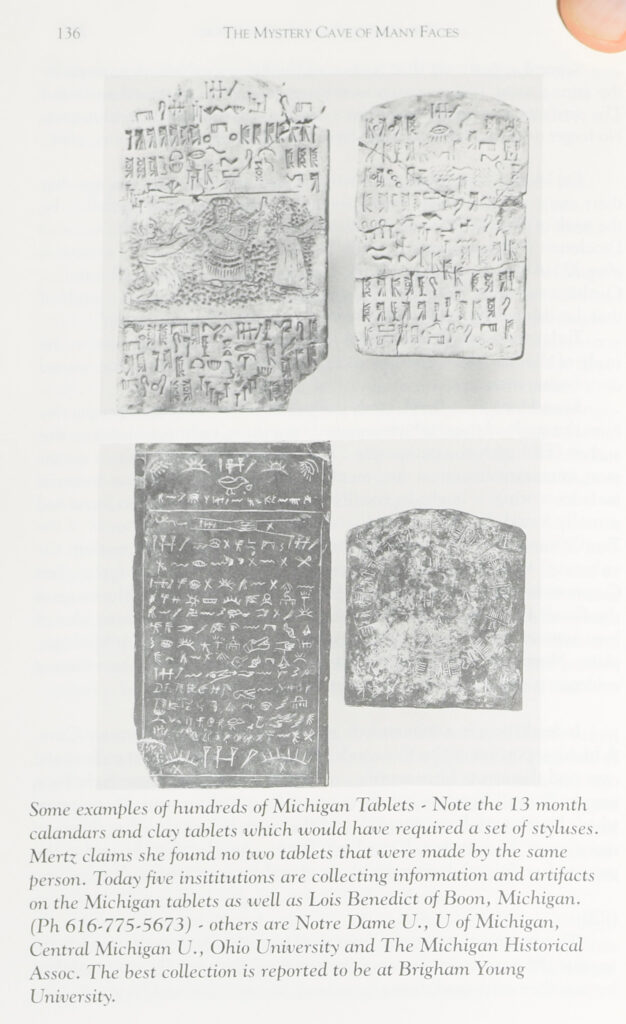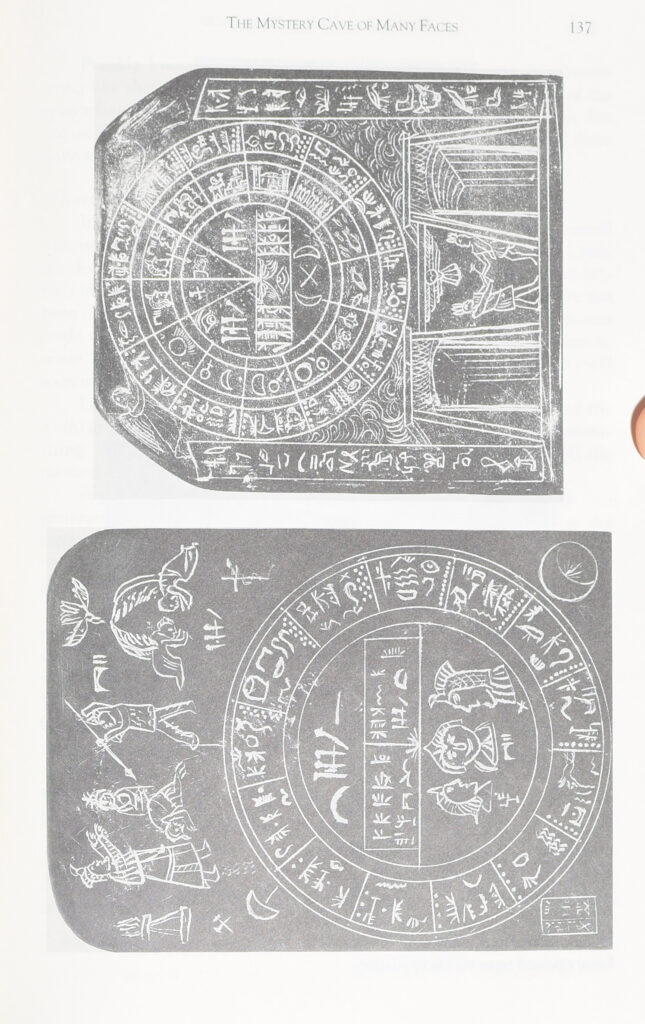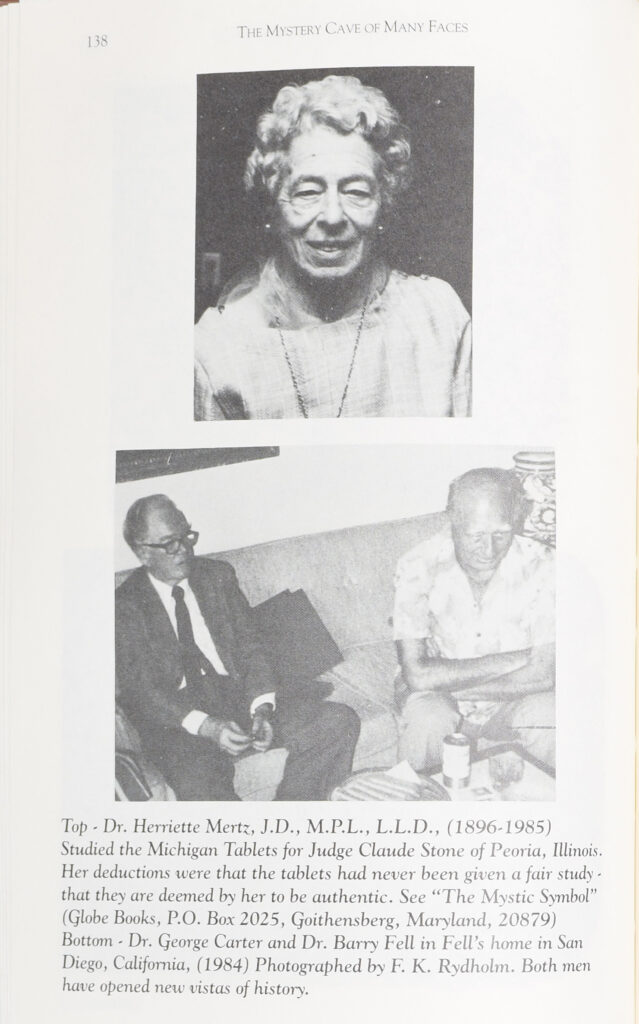Written by Fred Rydholm:
About a century ago there was a great controversy in Michigan, Indiana, Ohio and Illinois over strange artifacts found between 1874 and 1915 in Indian mounds (mainly in seventeen counties of lower Michigan). Among these artifacts were many large tablets made of clay, slate, stone and (in a few cases) copper. These collectively have been called the Soper or Michigan Tablets. They are clearly derived from old world sources.
The men involved in finding these artifacts were tried in the newspapers and declared fakes and frauds by the public. All traces of these mound artifacts were removed from museums across the country, and the scholars of that time decided that no one had come to America or even knew it was here, until it was discovered in 1492 by Columbus.
Like the Burrows’ Cave material, the Soper Plates appear to be hodgepodge of Mediterranean scripts and languages that cannot be read by competent epigraphers. Dr. Fell claims that besides being unreadable, one of the copper plates is a modern alloy of copper. We know that there have been coppersmiths, smelters and artisans around for better than six thousand years. In ancient times every possible alloy of copper was tried and used. A conclusion based on the contents of a copper alloy cannot be definitive.
Some years ago, Judge Claude Stone of Peoria, Illinois asked Henriette Mertz (a famous Chicago lawyer and a pioneer in the study of pre-Columbian contacts with America) if she would re-examine the surviving specimens according to the rules and procedures of law – to give them, so to speak, the fair trial which they had never had. No one had ever subjected them to modern tests, some of which have only been developed recently; in fact, as with the Burrows’ Cave material, many archaeologists and other experts refused even to look at them.
Mertz took them through each step of analysis, and enlisted each type of modern expert. She estimated that between 3,000 and 10,000 artifacts had been recovered, and many others remained undiscovered. The tablets were mostly of slate and clay, but there were a few of copper.
Several experts say that no two of the known tablets were done by the same person. (Of every ten mounds opened, two contained artifacts.) The artifacts were made in different ways, using a variety of techniques. No forger or team of forgers could have carried out such an elaborate plan.
Dr. Mertz’s conclusion, after lengthy tests and deliberations, was that there was no sign of fraud. She believed the artifacts and inscriptions to be the work of up to 20,000 refugees “fleeing from the persecutions of Decius or Diocletian (Roman emperors of the 3rd and 4th centuries AD) sometime after 321 AD and sailing out of the harbors of Rome, Naples, Alexandria, Carthage and other Eastern Mediterranean ports and, to the known world of that day, assumed lost in the turbulent waters of the North Atlantic.”
Today there is a growing number of scholars who are engrossed in the study of the Michigan Tablets, and great headway is being made toward deciphering them.
Evan Hanson of Beryl, Utah has gained a new historical perspective from the study of these tablets summed up a thirty-eight page letter to this author (FR) with the paragraph: “The Michigan plates (tablets) are the most important historical documents ever found! If the Burrows material includes writing, it might be equally important. Even if Indiana Jones had actually found the Ark of the Covenant, and if the actual stones of the Ten Commandments were still inside, even that would be less than the value of the Michigan plates! We know the text of the Ten Commandments, but only the Michigan plates are giving us the cause of the flood! I had to put 38 pages in this so you would have some idea of how massive is the evidence that points to authenticity of the Michigan plates. None of it is strong enough to be proof – yet – but the sheer mass of evidence is about as close to being proof as one can get.”
Indeed there is a tremendous amount of “writing” in Burrows’ Cave. A high proportion of the thousands of rocks have writing, the walls of the cave and the crypts have writing, and there are scrolls. These have been
seen by Russell Burrows but there are at least eight or nine more crypts which have never been entered, and there are indications that there are more caves. In contrast, King Tut’s Tomb, considered to be one of the great archaeological discoveries of our time, has no writing at all.
(Russell Burrows):
The experts in epigraphy from the Epigraphic Society are now claiming that the entire assortment of artifacts from Burrows’ Cave is fraudulent because they can’t read them.



Frankly, I would be more concerned about the authenticity of something like these artifacts if they could be deciphered easily. None of the epigraphers have seen any of the real stones, just drawings or pictures. But archaeologists who have seen the artifacts first-hand and handled them have said just the opposite. Not one of them have said “Fake!”
(Fred Rydholm resumes):
It just seems very strange that anyone should be making any overall judgments until the cave has been thoroughly studied by competent, openminded people. All statements about the authenticity of the cave and artifacts are premature until the scientific study is made. People who have not been close enough to see for themselves really should not have their minds made up until that time. There are literally hundreds of tests that can be made and while no single test can stand by itself, a pattern of results will soon evolve which will prove whether the cave is authentic or not.
Like the epigraphers, many highly specialized scientists around the world are working on their fool-proof methods to prove or disprove something. While each method proves its bit, it is only the total of all the methods that will count in the end.
A good example is epigraphy. The people from the cave could be a generation or two, or even more, removed from the homelands of the scripts, and much could have changed in that time. They could even be trying to use Old World scripts and alphabets to record a new language, possibly a long-lost Amerindian tongue.
There is a highly respected metallurgist who has “fingerprinted” many of the ancient copper mines of Upper Michigan, that is, he has determined the exact amounts of foreign substances in the copper from each mine. His idea is that if he can find a piece of raw copper in the Old World that matches one from a mine in Michigan then it surely came from there. The hitch is that probably 98% if not all of the copper that would have come from America would have been “worked,” smelted, alloyed, or mixed with copper from elsewhere. These possibilities make the test inconclusive and the chances are almost negligible of find piece of raw copper suitable for testing.
There have even been great discrepancies found in radio-carbon dating, although it is becoming more refined and understood as time goes on. It seems that any one test has room for dispute.